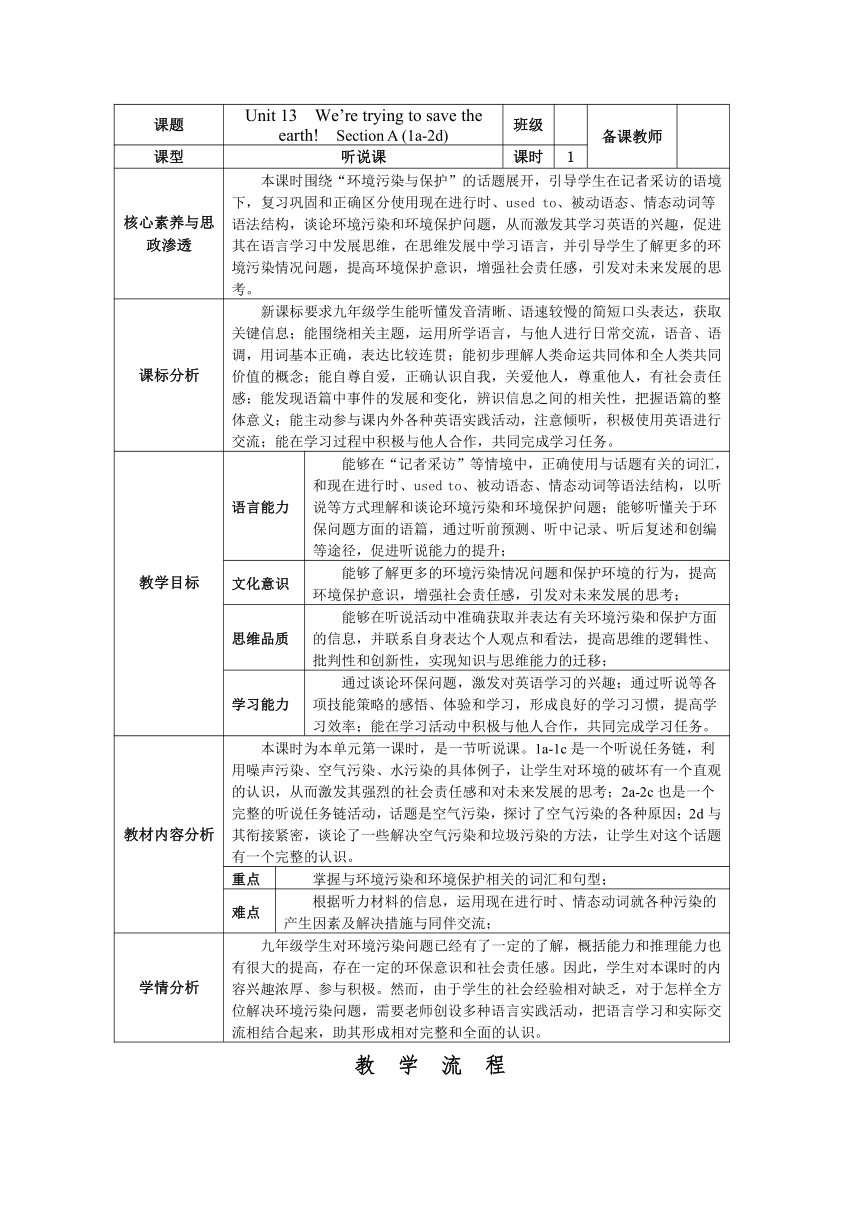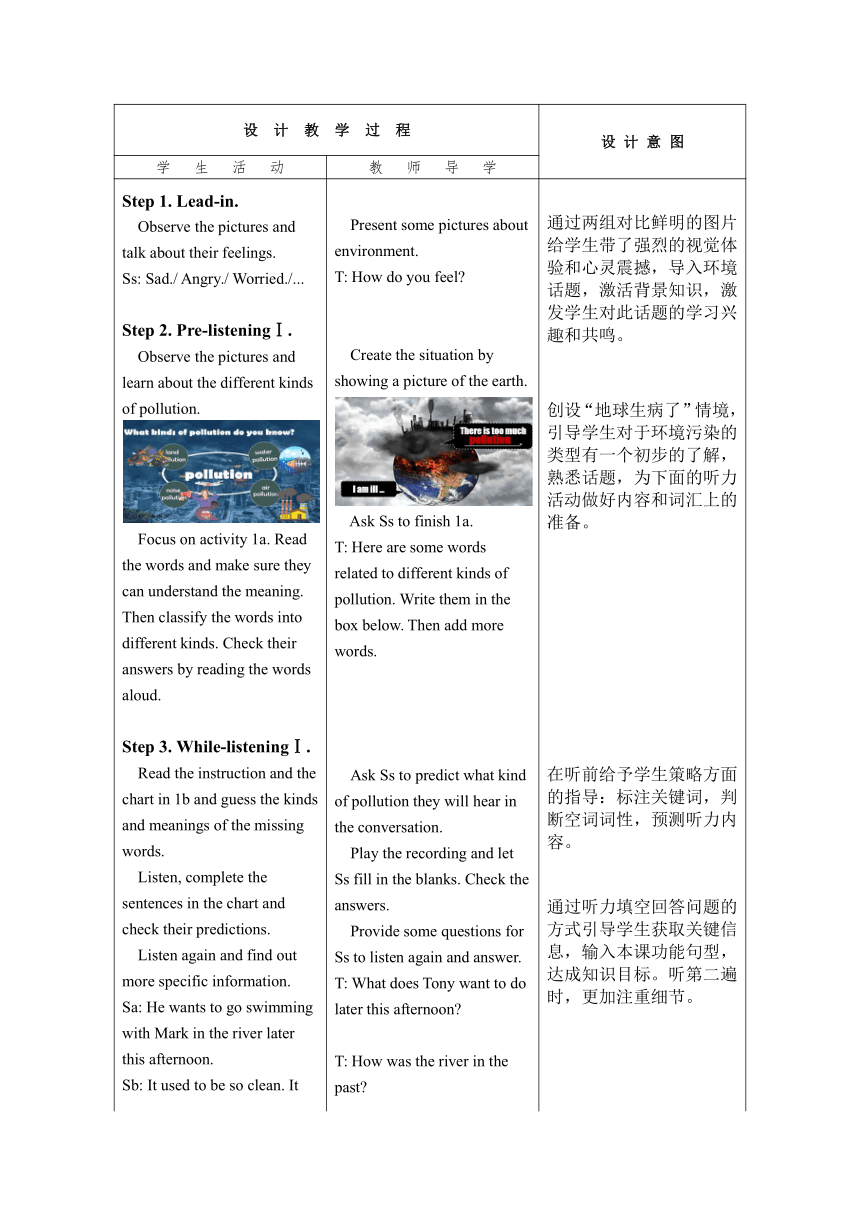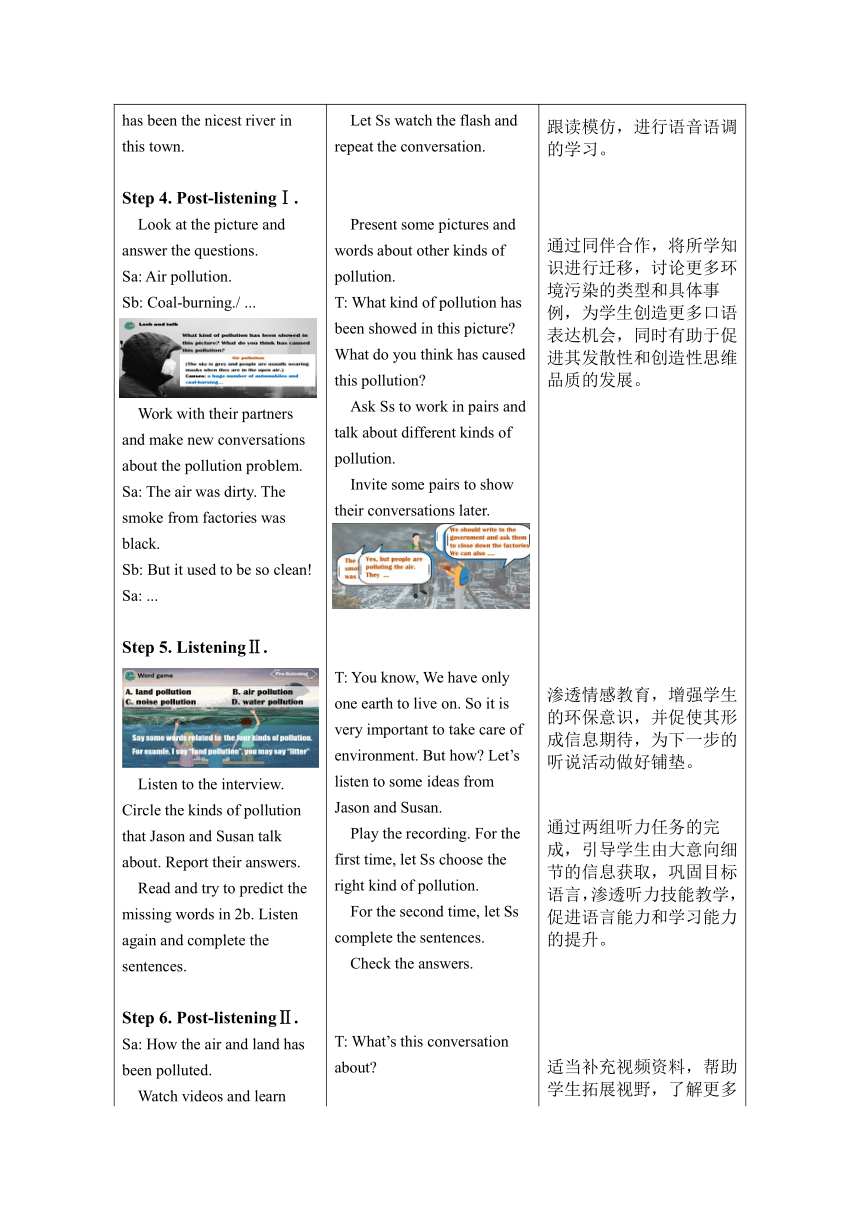【核心素养目标】Unit 13 We’re trying to save the earth! Section A (1a-2d) 表格式教案
文档属性
| 名称 | 【核心素养目标】Unit 13 We’re trying to save the earth! Section A (1a-2d) 表格式教案 |  | |
| 格式 | docx | ||
| 文件大小 | 2.7MB | ||
| 资源类型 | 教案 | ||
| 版本资源 | 人教新目标(Go for it)版 | ||
| 科目 | 英语 | ||
| 更新时间 | 2024-09-25 16:09:15 | ||
图片预览



文档简介
课题 Unit 13 We’re trying to save the earth! Section A (1a-2d) 班级 备课教师
课型 听说课 课时 1
核心素养与思政渗透 本课时围绕“环境污染与保护”的话题展开,引导学生在记者采访的语境下,复习巩固和正确区分使用现在进行时、used to、被动语态、情态动词等语法结构,谈论环境污染和环境保护问题,从而激发其学习英语的兴趣,促进其在语言学习中发展思维,在思维发展中学习语言,并引导学生了解更多的环境污染情况问题,提高环境保护意识,增强社会责任感,引发对未来发展的思考。
课标分析 新课标要求九年级学生能听懂发音清晰、语速较慢的简短口头表达,获取关键信息;能围绕相关主题,运用所学语言,与他人进行日常交流,语音、语调,用词基本正确,表达比较连贯;能初步理解人类命运共同体和全人类共同价值的概念;能自尊自爱,正确认识自我,关爱他人,尊重他人,有社会责任感;能发现语篇中事件的发展和变化,辨识信息之间的相关性,把握语篇的整体意义;能主动参与课内外各种英语实践活动,注意倾听,积极使用英语进行交流;能在学习过程中积极与他人合作,共同完成学习任务。
教学目标 语言能力 能够在“记者采访”等情境中,正确使用与话题有关的词汇,和现在进行时、used to、被动语态、情态动词等语法结构,以听说等方式理解和谈论环境污染和环境保护问题;能够听懂关于环保问题方面的语篇,通过听前预测、听中记录、听后复述和创编等途径,促进听说能力的提升;
文化意识 能够了解更多的环境污染情况问题和保护环境的行为,提高环境保护意识,增强社会责任感,引发对未来发展的思考;
思维品质 能够在听说活动中准确获取并表达有关环境污染和保护方面的信息,并联系自身表达个人观点和看法,提高思维的逻辑性、批判性和创新性,实现知识与思维能力的迁移;
学习能力 通过谈论环保问题,激发对英语学习的兴趣;通过听说等各项技能策略的感悟、体验和学习,形成良好的学习习惯,提高学习效率;能在学习活动中积极与他人合作,共同完成学习任务。
教材内容分析 本课时为本单元第一课时,是一节听说课。1a-1c是一个听说任务链,利用噪声污染、空气污染、水污染的具体例子,让学生对环境的破坏有一个直观的认识,从而激发其强烈的社会责任感和对未来发展的思考;2a-2c也是一个完整的听说任务链活动,话题是空气污染,探讨了空气污染的各种原因;2d与其衔接紧密,谈论了一些解决空气污染和垃圾污染的方法,让学生对这个话题有一个完整的认识。
重点 掌握与环境污染和环境保护相关的词汇和句型;
难点 根据听力材料的信息,运用现在进行时、情态动词就各种污染的产生因素及解决措施与同伴交流;
学情分析 九年级学生对环境污染问题已经有了一定的了解,概括能力和推理能力也有很大的提高,存在一定的环保意识和社会责任感。因此,学生对本课时的内容兴趣浓厚、参与积极。然而,由于学生的社会经验相对缺乏,对于怎样全方位解决环境污染问题,需要老师创设多种语言实践活动,把语言学习和实际交流相结合起来,助其形成相对完整和全面的认识。
教 学 流 程
设 计 教 学 过 程 设 计 意 图
学 生 活 动 教 师 导 学
Step 1. Lead-in. Observe the pictures and talk about their feelings. Ss: Sad./ Angry./ Worried./... Step 2. Pre-listeningⅠ. Observe the pictures and learn about the different kinds of pollution. Focus on activity 1a. Read the words and make sure they can understand the meaning. Then classify the words into different kinds. Check their answers by reading the words aloud. Step 3. While-listeningⅠ. Read the instruction and the chart in 1b and guess the kinds and meanings of the missing words. Listen, complete the sentences in the chart and check their predictions. Listen again and find out more specific information. Sa: He wants to go swimming with Mark in the river later this afternoon. Sb: It used to be so clean. It has been the nicest river in this town. Step 4. Post-listeningⅠ. Look at the picture and answer the questions. Sa: Air pollution. Sb: Coal-burning./ ... Work with their partners and make new conversations about the pollution problem. Sa: The air was dirty. The smoke from factories was black. Sb: But it used to be so clean! Sa: ... Step 5. ListeningⅡ. Listen to the interview. Circle the kinds of pollution that Jason and Susan talk about. Report their answers. Read and try to predict the missing words in 2b. Listen again and complete the sentences. Step 6. Post-listeningⅡ. Sa: How the air and land has been polluted. Watch videos and learn more about the air pollution and soil pollution. Then listen and repeat sentence by sentence. Use the information in 2a and 2b to role-play conversations between Jason and Susan. Step 7. Role-play. Read the conversation in 2d and fill in the chart. Sa: take the bus or subway instead of driving, never take wooden chopsticks or plastic forks... Try to role-play the conversation in pairs. Step 8. Group work. Watch a video about protecting the environment. Talk about the different kinds of pollution and share their ideas for solving these problems. Then write them down on their proposals. Step 9. Conclusion. Have a summary with the help of T. Present some pictures about environment. T: How do you feel Create the situation by showing a picture of the earth. Ask Ss to finish 1a. T: Here are some words related to different kinds of pollution. Write them in the box below. Then add more words. Ask Ss to predict what kind of pollution they will hear in the conversation. Play the recording and let Ss fill in the blanks. Check the answers. Provide some questions for Ss to listen again and answer. T: What does Tony want to do later this afternoon T: How was the river in the past Let Ss watch the flash and repeat the conversation. Present some pictures and words about other kinds of pollution. T: What kind of pollution has been showed in this picture What do you think has caused this pollution Ask Ss to work in pairs and talk about different kinds of pollution. Invite some pairs to show their conversations later. T: You know, We have only one earth to live on. So it is very important to take care of environment. But how Let’s listen to some ideas from Jason and Susan. Play the recording. For the first time, let Ss choose the right kind of pollution. For the second time, let Ss complete the sentences. Check the answers. T: What’s this conversation about Explain some language points. Let Ss work in pairs and make conversations. Invite some pairs to show themselves. Provide the chart for Ss to catch the information about pollution problems and ways to solve them. T: How can we help change this situation What are Jason’s and Susan’s opinions T: Our actions can make a difference and lead to a better future! Explain the language points and play the flash and ask Ss to imitate. T: What are your ideas for solving the problem of air pollution 通过两组对比鲜明的图片给学生带了强烈的视觉体验和心灵震撼,导入环境话题,激活背景知识,激发学生对此话题的学习兴趣和共鸣。 创设“地球生病了”情境,引导学生对于环境污染的类型有一个初步的了解,熟悉话题,为下面的听力活动做好内容和词汇上的准备。 在听前给予学生策略方面的指导:标注关键词,判断空词词性,预测听力内容。 通过听力填空回答问题的方式引导学生获取关键信息,输入本课功能句型,达成知识目标。听第二遍时,更加注重细节。 跟读模仿,进行语音语调的学习。 通过同伴合作,将所学知识进行迁移,讨论更多环境污染的类型和具体事例,为学生创造更多口语表达机会,同时有助于促进其发散性和创造性思维品质的发展。 渗透情感教育,增强学生的环保意识,并促使其形成信息期待,为下一步的听说活动做好铺垫。 通过两组听力任务的完成,引导学生由大意向细节的信息获取,巩固目标语言,渗透听力技能教学,促进语言能力和学习能力的提升。 适当补充视频资料,帮助学生拓展视野,了解更多关于空气污染和土地污染的知识。让学生模仿语音语调,提高口语表达能力。 在同伴交流中,提醒学生看着同伴的眼睛,体会交流的真实性,避免各自读各自的内容。 通过表格信息罗列方式引导学生关注细节性的语言点知识,在语言内化和能力提升中兼顾基础知识的落实。通过角色扮演的形式引导学生关注语音语调、肢体语言等。 通过小组合作制定出环保倡议书,将所学知识进行内化、迁移、运用,促进思维品质的发展、合作精神的增强和写作能力的提高。 情感教育,提高学生的环保意识和社会责任感,引发对未来发展的思考。
课 时 达 标 检 测
I.根据句意和汉语提示写出所缺的单词。 1. Don’t throw the (垃圾) on the ground. You should throw it into the bin. 2. Can you find something special in the (底部) of the bottle 3. Some (渔民) lived in the small village. 4. The lady is (难看的), but she likes to dress up as a princess. 5. What’s the (优点) of the new project II.根据汉语和所给的提示词翻译句子。 1. 甚至那条河的底部也全是垃圾。(even, full) . 2. 这条河以前很干净。(used) . 3. 你想参与这个活动吗?(would, part) 4. 为了减少空气污染,我们应该乘坐公共汽车,而不是开车。(order, cut, instead) . 5. 那位老师对我的未来影响很大。(make, great) . III.补全对话。 从方框内选择恰当的选项补全对话,使句意完整、符合逻辑。(其中有两项为多余选项) On a hot summer day, Bob is talking to his friend Ann at the beach. (B is for Bob; A is for Ann.) B: Hi, Ann! I’m really happy to see you again. How’s it going A: 1 Nice to see you, too! B: It’s great that you come to join us! A: I came because I like your idea: when you give, you’re rich. B: Right. That’s why we had this plan to get our clean beach back. 2 I remember he had the same idea and said he would try his best to come over. A: I don’t think he’s coming. He just called and said it’s too hot today and he wouldn’t come. B: 3 He always says, “We can do this and that...”. A: Don’t you know him He only pays lip service to what should be done but seldom does anything. B: I see. 4 Steve and Helen will come and help us soon. A: That’s great. 5 Should we pick up those bottles first B: Sure, let’s go. A. Let’s forget about him. B. I can’t believe it! C. How about playing beach volleyball D. Pretty good! E. So where should we start now F. What should we do to help Peter G. Do you know if Peter’s coming
第 页
课 时 教 学 设 计 尾 页
板 书 设 计
Unit 13 We’re trying to save the earth! (Section A 1a-2d)
作 业 设 计
Level A Do more research on one kind of pollution and make a information card about it, including its causes, bad effects and solutions.
Level B Write a short passage to introduce Jason’s, Susan’s and your ideas for solving the pollution problems according to 2d.
教 学 反 思
第 页
课型 听说课 课时 1
核心素养与思政渗透 本课时围绕“环境污染与保护”的话题展开,引导学生在记者采访的语境下,复习巩固和正确区分使用现在进行时、used to、被动语态、情态动词等语法结构,谈论环境污染和环境保护问题,从而激发其学习英语的兴趣,促进其在语言学习中发展思维,在思维发展中学习语言,并引导学生了解更多的环境污染情况问题,提高环境保护意识,增强社会责任感,引发对未来发展的思考。
课标分析 新课标要求九年级学生能听懂发音清晰、语速较慢的简短口头表达,获取关键信息;能围绕相关主题,运用所学语言,与他人进行日常交流,语音、语调,用词基本正确,表达比较连贯;能初步理解人类命运共同体和全人类共同价值的概念;能自尊自爱,正确认识自我,关爱他人,尊重他人,有社会责任感;能发现语篇中事件的发展和变化,辨识信息之间的相关性,把握语篇的整体意义;能主动参与课内外各种英语实践活动,注意倾听,积极使用英语进行交流;能在学习过程中积极与他人合作,共同完成学习任务。
教学目标 语言能力 能够在“记者采访”等情境中,正确使用与话题有关的词汇,和现在进行时、used to、被动语态、情态动词等语法结构,以听说等方式理解和谈论环境污染和环境保护问题;能够听懂关于环保问题方面的语篇,通过听前预测、听中记录、听后复述和创编等途径,促进听说能力的提升;
文化意识 能够了解更多的环境污染情况问题和保护环境的行为,提高环境保护意识,增强社会责任感,引发对未来发展的思考;
思维品质 能够在听说活动中准确获取并表达有关环境污染和保护方面的信息,并联系自身表达个人观点和看法,提高思维的逻辑性、批判性和创新性,实现知识与思维能力的迁移;
学习能力 通过谈论环保问题,激发对英语学习的兴趣;通过听说等各项技能策略的感悟、体验和学习,形成良好的学习习惯,提高学习效率;能在学习活动中积极与他人合作,共同完成学习任务。
教材内容分析 本课时为本单元第一课时,是一节听说课。1a-1c是一个听说任务链,利用噪声污染、空气污染、水污染的具体例子,让学生对环境的破坏有一个直观的认识,从而激发其强烈的社会责任感和对未来发展的思考;2a-2c也是一个完整的听说任务链活动,话题是空气污染,探讨了空气污染的各种原因;2d与其衔接紧密,谈论了一些解决空气污染和垃圾污染的方法,让学生对这个话题有一个完整的认识。
重点 掌握与环境污染和环境保护相关的词汇和句型;
难点 根据听力材料的信息,运用现在进行时、情态动词就各种污染的产生因素及解决措施与同伴交流;
学情分析 九年级学生对环境污染问题已经有了一定的了解,概括能力和推理能力也有很大的提高,存在一定的环保意识和社会责任感。因此,学生对本课时的内容兴趣浓厚、参与积极。然而,由于学生的社会经验相对缺乏,对于怎样全方位解决环境污染问题,需要老师创设多种语言实践活动,把语言学习和实际交流相结合起来,助其形成相对完整和全面的认识。
教 学 流 程
设 计 教 学 过 程 设 计 意 图
学 生 活 动 教 师 导 学
Step 1. Lead-in. Observe the pictures and talk about their feelings. Ss: Sad./ Angry./ Worried./... Step 2. Pre-listeningⅠ. Observe the pictures and learn about the different kinds of pollution. Focus on activity 1a. Read the words and make sure they can understand the meaning. Then classify the words into different kinds. Check their answers by reading the words aloud. Step 3. While-listeningⅠ. Read the instruction and the chart in 1b and guess the kinds and meanings of the missing words. Listen, complete the sentences in the chart and check their predictions. Listen again and find out more specific information. Sa: He wants to go swimming with Mark in the river later this afternoon. Sb: It used to be so clean. It has been the nicest river in this town. Step 4. Post-listeningⅠ. Look at the picture and answer the questions. Sa: Air pollution. Sb: Coal-burning./ ... Work with their partners and make new conversations about the pollution problem. Sa: The air was dirty. The smoke from factories was black. Sb: But it used to be so clean! Sa: ... Step 5. ListeningⅡ. Listen to the interview. Circle the kinds of pollution that Jason and Susan talk about. Report their answers. Read and try to predict the missing words in 2b. Listen again and complete the sentences. Step 6. Post-listeningⅡ. Sa: How the air and land has been polluted. Watch videos and learn more about the air pollution and soil pollution. Then listen and repeat sentence by sentence. Use the information in 2a and 2b to role-play conversations between Jason and Susan. Step 7. Role-play. Read the conversation in 2d and fill in the chart. Sa: take the bus or subway instead of driving, never take wooden chopsticks or plastic forks... Try to role-play the conversation in pairs. Step 8. Group work. Watch a video about protecting the environment. Talk about the different kinds of pollution and share their ideas for solving these problems. Then write them down on their proposals. Step 9. Conclusion. Have a summary with the help of T. Present some pictures about environment. T: How do you feel Create the situation by showing a picture of the earth. Ask Ss to finish 1a. T: Here are some words related to different kinds of pollution. Write them in the box below. Then add more words. Ask Ss to predict what kind of pollution they will hear in the conversation. Play the recording and let Ss fill in the blanks. Check the answers. Provide some questions for Ss to listen again and answer. T: What does Tony want to do later this afternoon T: How was the river in the past Let Ss watch the flash and repeat the conversation. Present some pictures and words about other kinds of pollution. T: What kind of pollution has been showed in this picture What do you think has caused this pollution Ask Ss to work in pairs and talk about different kinds of pollution. Invite some pairs to show their conversations later. T: You know, We have only one earth to live on. So it is very important to take care of environment. But how Let’s listen to some ideas from Jason and Susan. Play the recording. For the first time, let Ss choose the right kind of pollution. For the second time, let Ss complete the sentences. Check the answers. T: What’s this conversation about Explain some language points. Let Ss work in pairs and make conversations. Invite some pairs to show themselves. Provide the chart for Ss to catch the information about pollution problems and ways to solve them. T: How can we help change this situation What are Jason’s and Susan’s opinions T: Our actions can make a difference and lead to a better future! Explain the language points and play the flash and ask Ss to imitate. T: What are your ideas for solving the problem of air pollution 通过两组对比鲜明的图片给学生带了强烈的视觉体验和心灵震撼,导入环境话题,激活背景知识,激发学生对此话题的学习兴趣和共鸣。 创设“地球生病了”情境,引导学生对于环境污染的类型有一个初步的了解,熟悉话题,为下面的听力活动做好内容和词汇上的准备。 在听前给予学生策略方面的指导:标注关键词,判断空词词性,预测听力内容。 通过听力填空回答问题的方式引导学生获取关键信息,输入本课功能句型,达成知识目标。听第二遍时,更加注重细节。 跟读模仿,进行语音语调的学习。 通过同伴合作,将所学知识进行迁移,讨论更多环境污染的类型和具体事例,为学生创造更多口语表达机会,同时有助于促进其发散性和创造性思维品质的发展。 渗透情感教育,增强学生的环保意识,并促使其形成信息期待,为下一步的听说活动做好铺垫。 通过两组听力任务的完成,引导学生由大意向细节的信息获取,巩固目标语言,渗透听力技能教学,促进语言能力和学习能力的提升。 适当补充视频资料,帮助学生拓展视野,了解更多关于空气污染和土地污染的知识。让学生模仿语音语调,提高口语表达能力。 在同伴交流中,提醒学生看着同伴的眼睛,体会交流的真实性,避免各自读各自的内容。 通过表格信息罗列方式引导学生关注细节性的语言点知识,在语言内化和能力提升中兼顾基础知识的落实。通过角色扮演的形式引导学生关注语音语调、肢体语言等。 通过小组合作制定出环保倡议书,将所学知识进行内化、迁移、运用,促进思维品质的发展、合作精神的增强和写作能力的提高。 情感教育,提高学生的环保意识和社会责任感,引发对未来发展的思考。
课 时 达 标 检 测
I.根据句意和汉语提示写出所缺的单词。 1. Don’t throw the (垃圾) on the ground. You should throw it into the bin. 2. Can you find something special in the (底部) of the bottle 3. Some (渔民) lived in the small village. 4. The lady is (难看的), but she likes to dress up as a princess. 5. What’s the (优点) of the new project II.根据汉语和所给的提示词翻译句子。 1. 甚至那条河的底部也全是垃圾。(even, full) . 2. 这条河以前很干净。(used) . 3. 你想参与这个活动吗?(would, part) 4. 为了减少空气污染,我们应该乘坐公共汽车,而不是开车。(order, cut, instead) . 5. 那位老师对我的未来影响很大。(make, great) . III.补全对话。 从方框内选择恰当的选项补全对话,使句意完整、符合逻辑。(其中有两项为多余选项) On a hot summer day, Bob is talking to his friend Ann at the beach. (B is for Bob; A is for Ann.) B: Hi, Ann! I’m really happy to see you again. How’s it going A: 1 Nice to see you, too! B: It’s great that you come to join us! A: I came because I like your idea: when you give, you’re rich. B: Right. That’s why we had this plan to get our clean beach back. 2 I remember he had the same idea and said he would try his best to come over. A: I don’t think he’s coming. He just called and said it’s too hot today and he wouldn’t come. B: 3 He always says, “We can do this and that...”. A: Don’t you know him He only pays lip service to what should be done but seldom does anything. B: I see. 4 Steve and Helen will come and help us soon. A: That’s great. 5 Should we pick up those bottles first B: Sure, let’s go. A. Let’s forget about him. B. I can’t believe it! C. How about playing beach volleyball D. Pretty good! E. So where should we start now F. What should we do to help Peter G. Do you know if Peter’s coming
第 页
课 时 教 学 设 计 尾 页
板 书 设 计
Unit 13 We’re trying to save the earth! (Section A 1a-2d)
作 业 设 计
Level A Do more research on one kind of pollution and make a information card about it, including its causes, bad effects and solutions.
Level B Write a short passage to introduce Jason’s, Susan’s and your ideas for solving the pollution problems according to 2d.
教 学 反 思
第 页
同课章节目录
- Unit 1 How can we become good learners.
- Section A
- Section B
- Unit 2 I think that mooncakes are delicious!
- Section A
- Section B
- Unit 3 Could you please tell me where the restroom
- Section A
- Section B
- Unit 4 I used to be afraid of the dark.
- Section A
- Section B
- Unit 5 What are the shirts made of?
- Section A
- Section B
- Review of Units 1-5
- Unit 6 When was it invented?
- Section A
- Section B
- Unit 7 Teenagers should be allowed to choose their
- Section A
- Section B
- Unit 8 It must belong to Carla.
- Section A
- Section B
- Unit 9 I like music that I can dance to.
- Section A
- Section B
- Unit 10 You're supposed to shake hands.
- Section A
- Section B
- Review of Units 6-10
- Unit 11 Sad movies make me cry.
- Section A
- Section B
- Unit 12 Life is full of the unexpected
- Section A
- Section B
- Unit 13 We're trying to save the earth!
- Section A
- Section B
- Unit 14 I remember meeting all of you in Grade 7.
- Section A
- Section B
- Review of Units 11-14
